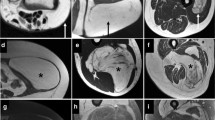Abstract
Objective, design and patients
Hibernoma is an uncommon, slow-growing, benign soft-tissue tumour resembling brown adipose tissue. The histological appearances are well-documented, but there are relatively few descriptions of the magnetic resonance (MR) imaging features. We report a retrospective comparison of the histological and MR appearances of ten hibernomas of the extremities, classified histologically into lipoma-like [<70% multivacuolated adipocytes (MVAs)] and non-lipoma-like hibernomas (>70% MVAs).
Results
The lipoma-like hibernomas measured 4–27 cm in maximum size. All were well-defined on MR imaging and histology except for one subcutaneous lesion that blended in with surrounding fat histologically. All lesions were isointense with subcutaneous fat on T1- and T2-weighting apart from one lesion that was predominantly slightly hypointense on T1-weighting and predominantly slightly hyperintense on T2-weighting and STIR. Two slightly inhomogeneous lesions contained thin (<5 mm thickness) tortuous vessels. One patient received intravenous contrast, but the lesion did not enhance. The six non-lipoma-like hibernomas measured 2.5–15.5 cm in maximum size and all were unencapsulated. Three were well-defined and three partly ill-defined on MR imaging. There were no significant differences in the MR characteristics of the non-lipoma-like variants. On T1-weighting, the non-lipoma-like hibernomas that contained >90% MVAs were predominantly slightly hypointense to subcutaneous fat. One lesion was isointense with subcutaneous fat, but this lesion only contained from 80–90% MVAs. All non-lipoma-like lesions were slightly hyperintense on STIR but so too were two of the four lipoma-like lesions. Four of the six non-lipoma-like lesions showed marked or moderate inhomogeneity due to thick septa and prominent vessels. Of the two cases that received intravenous contrast, both showed enhancement corresponding to regions of >90% MVAs or prominent vessels within fibrous septa.
Conclusions
MR imaging has shown some distinguishing features between lipoma-like and non-lipoma-like hibernomas. Lipoma-like hibernomas are usually isointense with subcutaneous fat on T1-weighting, are either homogeneous or slightly inhomogeneous and may contain thin tortuous vascular structures. Non-lipoma-like hibernomas are pre-dominantly slightly hypointense to subcutaneous fat on T1-weighting, often display marked or moderate inhomogeneity with prominent septa and vessels and enhancement is typical. The appearances of non-lipoma-like hibernomas are not diagnostic and may be mimicked by lipoma variants and by well-differentiated liposarcoma or atypical lipoma.








Similar content being viewed by others
References
Weiss SW, Goldblum JR. Benign lipomatous tumors. In: Weiss SW, Goldblum JR, editors. Soft tissue tumors, 4th ed. St. Louis: Mosby; 2001. pp 624–628
Furlong MA, Fanburg-Smith JC, Miettinen M. The morphological spectrum of hibernoma. A clinicopathologic study of 120 cases. Am J Surg Pathol 2001;25:809–814
Miettinen MM, Fanburg-Smith JC, Mandahl N. Hibernoma. In: Fletcher CDM, Unni KK, Mertens F, editors. World Health Organisation classification of tumours. Pathology and genetics of tumours of soft tissue and bone. Lyon: IARC Press; 2002. pp 33–35
Seynaeve P, Mortelmans L, Kockx M, Van Hoye M. Case report 813. Hibernoma of the left thigh. Skeletal Radiol 1994;23:137–138
Deseran MW, Seeger LL, Doberneck SA, Eckhardt JJ. Hibernoma of the right gracilis muscles. Skeletal Radiol 1994;23:301–302
Lateur L, Van Ongeval C, Samson I, et al. Case report 842. Benign hibernoma. Skeletal Radiol 1994;23:306–309
Atilla S, Eilenberg SS, Brown JJ. Hibernoma: MRI appearance of a rare tumor. Magn Reson Imaging 1995;13:335–337
Alvine G, Rosenthal H, Murphey M, Huntrakoon M. Hibernoma. Skeletal Radiol 1996;25:493–496
Cook MA, Stern M, de Silva RD. MRI of a hibernoma. J Comput Assist Tomogr 1996;20:333–335
Lewandowski PJ, Weiner SD. Hibernoma of the medial thigh. Case report and literature review. Clin Orthop 1996;330:198–201
Peer S, Kuhberger R, Dessl A, Judmaier W. MR imaging findings in hibernoma. Skeletal Radiol 1997;26:507
Chitoku S, Kawai S, Watabe Y, et al. Intradural spinal hibernoma: case report. Surg Neurol 1998;49:509–512
Mugel T, Ghossain MA, Guinet C, et al. MR and CT findings in a case of hibernoma of the thigh extending into the pelvis. Eur Radiol 1998;8:476–478
Anderson SE, Schwab C, Stauffer E, Banic A, Steinbach LS. Hibernoma: imaging characteristics of a rare benign soft tissue tumor. Skeletal Radiol 2001;30:590–595
Kallas KM, Vaughan L, Haghighi P, Resnick D. Hibernoma of the left axilla; a case report and review of MR imaging. Skeletal Radiol 2003;32:290–294
Worsey J, McGuirt W, Carrau R, et al. Hibernoma of the neck: a rare cause of neck mass. Am J Otolaryngol 1994;15:152–154
Murphey MD, Carroll JF, Flemming DJ, et al. Benign musculoskeletal lipomatous lesions. Radiographics 2004;24:1433–1466
Bancroft LW, Kransdorf MJ, Peterson JL, et al. Imaging characteristics of spindle cell lipoma. Am J Roentgenol 2003;181:1251–1254
Suh JS, Cho J, Lee SH, et al. Alveolar soft part sarcoma. MR and angiographic findings. Skeletal Radiol 2000;29:680–689
Author information
Authors and Affiliations
Corresponding author
Rights and permissions
About this article
Cite this article
Ritchie, D.A., Aniq, H., Davies, A.M. et al. Hibernoma—correlation of histopathology and magnetic-resonance-imaging features in 10 cases. Skeletal Radiol 35, 579–589 (2006). https://doi.org/10.1007/s00256-006-0114-4
Received:
Revised:
Accepted:
Published:
Issue Date:
DOI: https://doi.org/10.1007/s00256-006-0114-4




